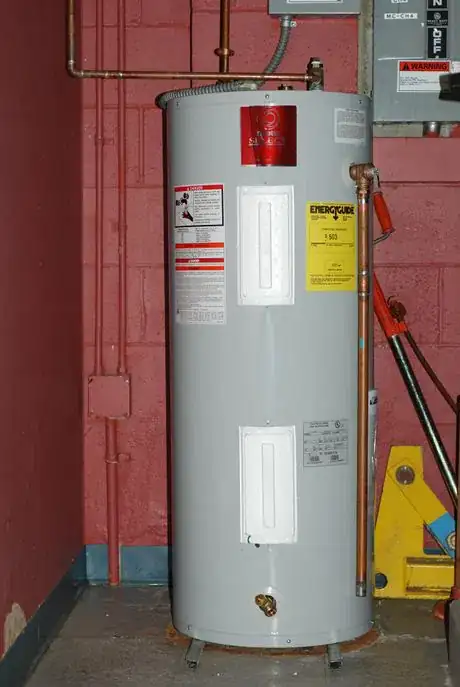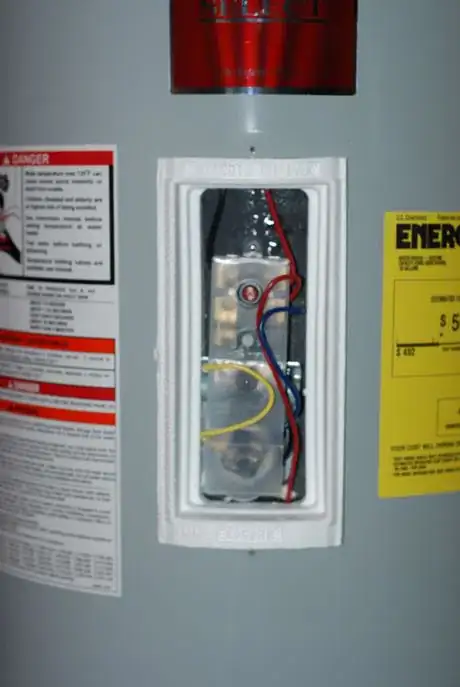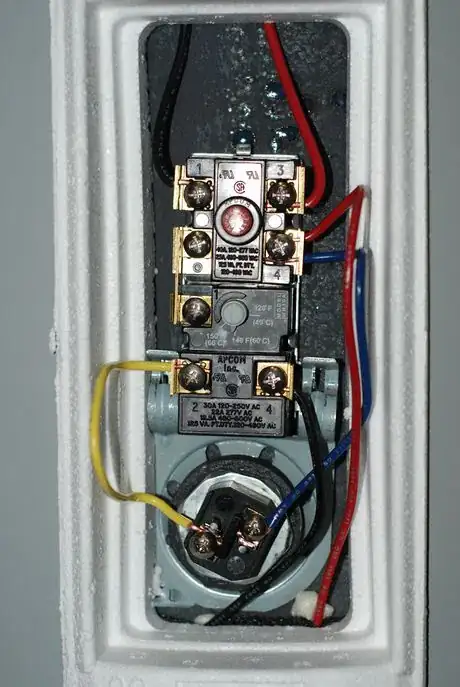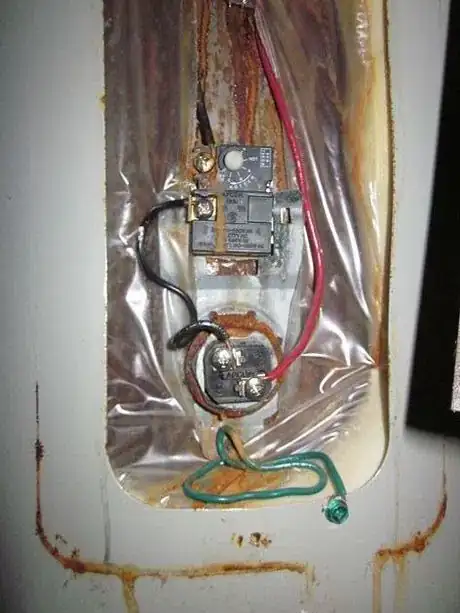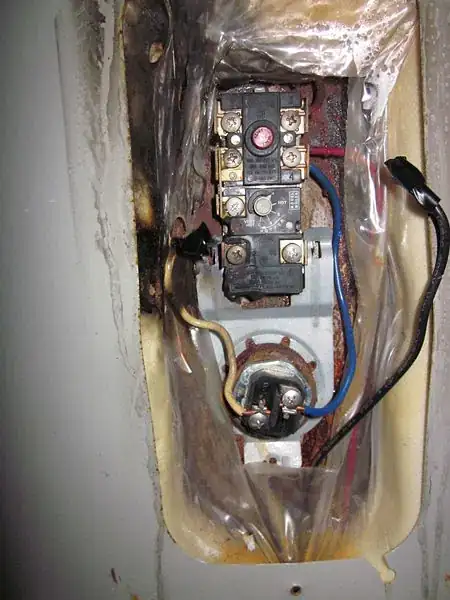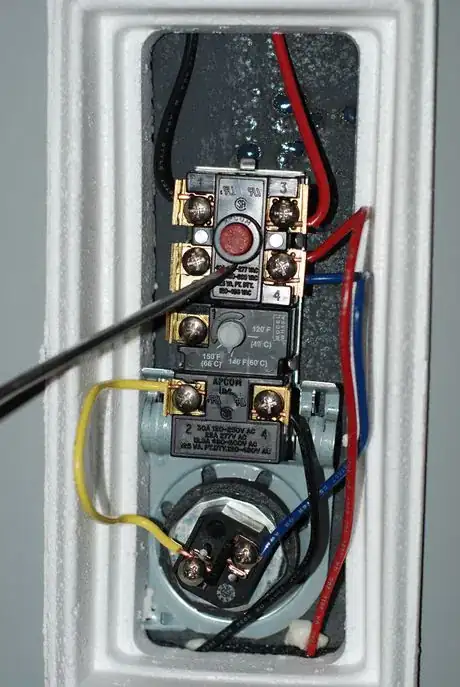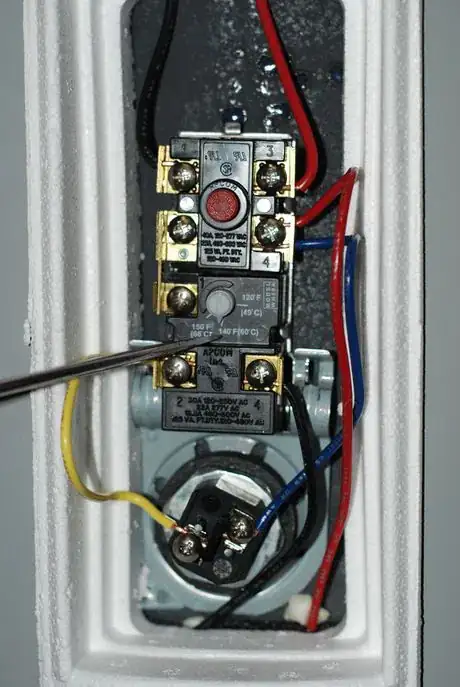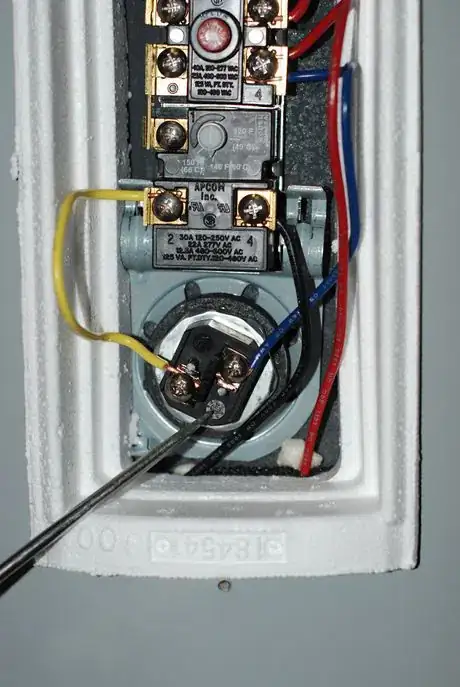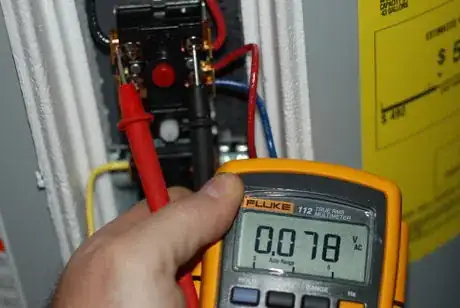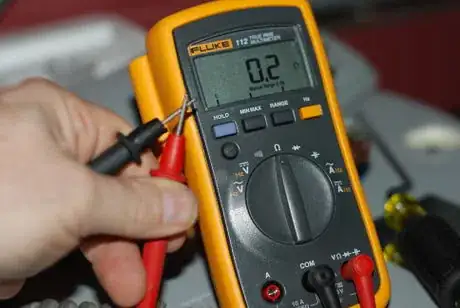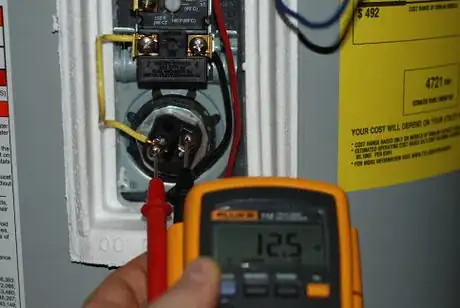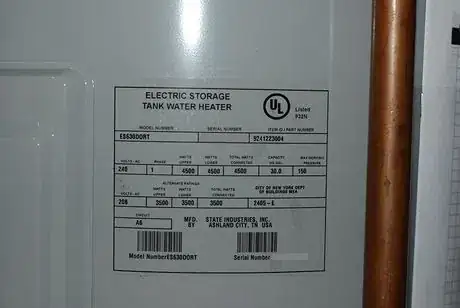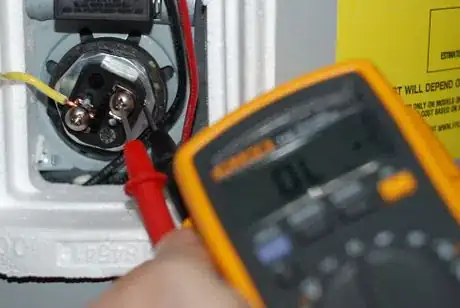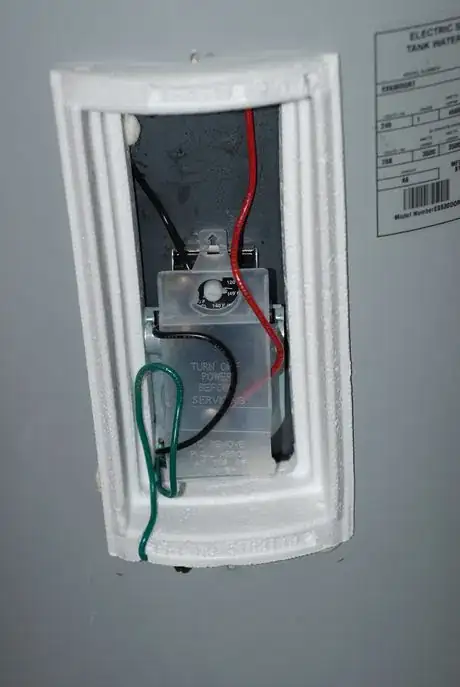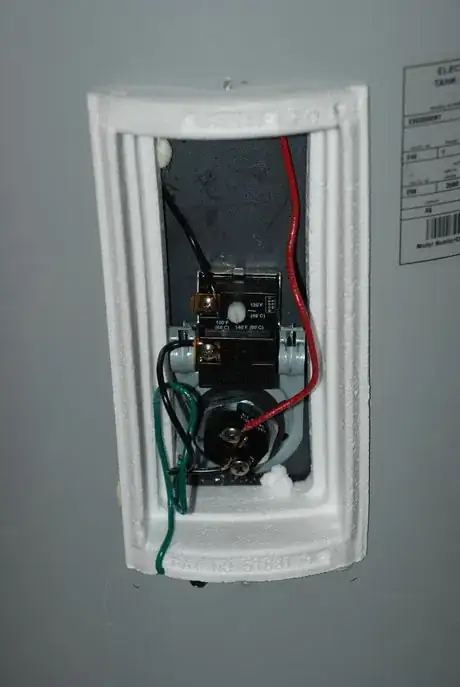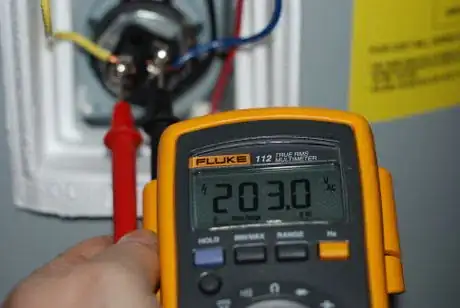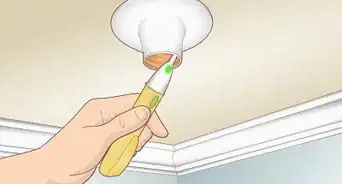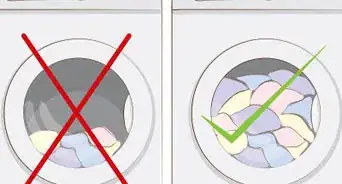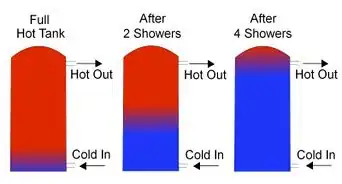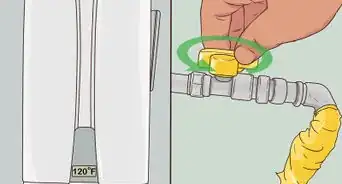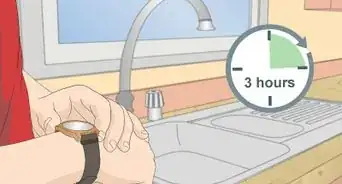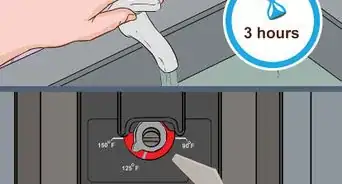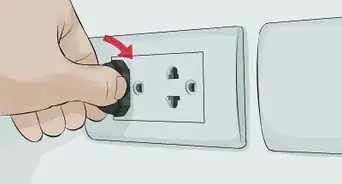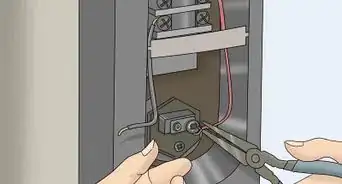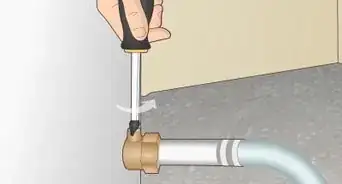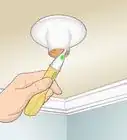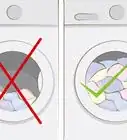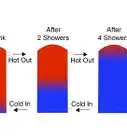This article was co-authored by Patrick Johns. Patrick Johns is a Home Improvement Specialist and the Owner of CatchAll Handyman Services. With more than 28 years of experience, he has worked on a variety of home improvement projects, such as carpentry, plumbing, and door and window installations in both commercial and residential properties.
There are 10 references cited in this article, which can be found at the bottom of the page.
This article has been viewed 854,422 times.
Ran out of hot water? You can easily repair (and replace if necessary) the controls and heating elements of most common residential 120, 208 and 240 volt electric water heaters with traditional line voltage controls; not the microprocessor types that are starting to appear in stores. Further, it does not discuss gas or propane fuel types nor plumbing related issues. This is a detailed, comprehensive article with additional help on the discussion page.
Steps
Repairing a Heater
-
1Check electrical panel to be sure that circuit breaker is in the "On" position (not in tripped or off) or fuses (if used) are installed securely and not "blown". Reset circuit breaker to "On" or replace any blown fuse(s) and wait 30 - 60 minutes for the water to warm. If water has remained cool, continue troubleshooting steps below.
-
2Shut off the power. Most water heaters are supplied by voltages that can cause shock, burns and even death should an energized conductor come in contact with the body. Shut off power in the electrical panel by removing fuses or by moving the handle of a switch or circuit breaker dedicated to the water heater to the Off position. Completely remove and "pocket" the fuses or otherwise secure or lock the panel and place a note on the cover to alert everyone that work is being performed on the water heater circuit. This will prevent the accidental energizing of the circuit while you are working on it.[1]Advertisement
-
3Remove the upper (and if provided lower) access panel(s). The metal covers are usually held in place with screws. Remove the screws and save for reinstallation when done. Use a voltmeter or test light to check between wiring terminals and the grounded metal case of the tank to be sure that the power is off. If power is still on, do not proceed until you locate the fuse or circuit breaker supplying power. Lock off or secure the circuit breaker or remove fuses to prevent someone from turning the circuit on while you are working on the water heater.[2]
-
4Clear away any insulation blocking access or view of the controls (thermostat and high-temperature switch) and heating element. Once the thermal insulation has been removed, plastic shock protectors are visible. Carefully fold any wires away from the protective cover. Lift the tab at the top away from the clip and remove to access terminals.[3]
- View with plastic shock protector removed:
-
5Look for obvious signs of damage. Water heaters can leak as a result of a failing tank - but also due to poorly fitted or soldered cold water supply pipe / hot water output pipe or a poor seal between tank opening and heating element. If allowed to continue to leak, it will cause internal damage to the controls should water enter them.[4]
- Rust coats wires and controls - both outside and inside
- Rust is conductive - even when on the wire insulation. This can lead to potentially deadly shocks, heating and melting insulation and even burns. Sooty, black carbon deposits on surfaces indicate a short circuit. Chances are there is an exposed copper wire that may be difficult to see due to the carbon deposits that resulted from the short circuit.
- Wires may have been damaged and now suffer with a reduced circumference that is needed to safely carry the heating element electrical load. This point of damage also becomes a source of heat. It is very important to repair or replace all parts that have visible forms of water and short circuit damage. This includes wires, wire insulation, jumpers and the controls themselves. As mentioned above, rust is a conductor and provides unintended and unexpected paths for electricity. These unintended paths can be dangerous and make troubleshooting very difficult to perform.
- Here, the yellow wire between the control and element appears to have shorted to the tank (or other metal) leaving a sooty black deposit on the wire and above. Notice the lower left terminal of the thermostat. Excessive heat has caused the plastic around the terminal to begin to melt.
-
6Locate the parts below:[5]
- High Temperature Limit Switch: Has a reset button There will be (4) terminal screws / wires connected to it. Usually, the top two terminals have wires that go up to the field wiring compartment that bring the power to the rest of the water heater's controls and heating elements. The "upper controls" consist of the High-Temperature Limit Switch and Upper Thermostat. The "lower controls" refers to the Lower Thermostat (there is no High-Temperature Limit Switch for the lower section of most electric water heaters). Three of the four terminals are numbered and visible in the picture (#1, #3, & #4; the #2 terminal is not identified as it is connected directly to the thermostat below via factory installed jumper).
- Thermostat: Has a graduated, adjustable dial. The dial may indicate letters "A" "B" "C" etc., "warm, hot and hotter" or as in the case of the one pictured, the actual temperature in degrees. The thermostat is located just below the High Temp Limit Switch.
- Heating Element: Has two terminals with a wire connected to each. One of these wires is usually connected to the thermostat associated it (in these photos the thermostat is directly above it). It is usually located below the controls and supports the controls with a clip of some type (in this photo, it has two terminals and a gray metal clip attached to support the controls above).
-
7Test to ensure power is off. Set the meter for AC Volts and insert the black probe into the black or common jack, and the red probe into the red or Volts jack.
-
8Measure Voltage. Set the AC voltage range to the highest available. Touch the probes to the top terminals of the high temperature limit switch as shown in the image to the right. If desired, the range may be lowered to any desired - provided the range is greater than the voltage displayed at the highest range. If unable to prove power off, double check circuit panel. Do not proceed unless power is proved off; otherwise damage to meter is likely and shock or burns is possible in the steps that follow.[6]
- In the provided picture, the meter indicates 0.078 volts present. This is less than 1/10 of a volt, and is considered "off".
-
9Set the multimeter to Ohms or Resistance. Observe the meter indication. If an analog type, the needle or pointer will be resting at over the higher resistance values (left-most position) this is an "open circuit" indication. If digital meter is used, it may display "OL" or "1" ("1" without trailing or leading zeros). This OL or 1 indication represents a value greater than the meter is capable of displaying (similar to the way a calculator does) for "overload" or "infinity". Infinity in high resistance range is also called an "open circuit" or "Open Loop" (OL). Take note of this open circuit indication for this meter (when in a voltage or current range is selected and the meter displays OL or 1, the measurement should be taken again after adjusting the range upward). If you are unsure what your meter should read in an "OL situation", just leave the terminals unconnected to anything and not touching each other and switch the meter on, it should then indicate the resistance of the air between the terminals which should be infinity in normal conditions.[7]
-
10Remove one wire from the heating element, it does not matter which.[8]
-
11Connect the black test lead to the jack marked "Common".
-
12Connect the red test lead to the jack marked "Ohms" or "Resistance" if there are multiple jacks from which to choose.[9]
-
13Set the range (if provided) to R x 1. If the meter being used does not provide for range selection, it is likely an "autoranging" type. This simply means that the meter will automatically adjust the range up or down as needed without any intervention by the user. This feature is far more common on digital meters than analog types. Most analog meters that do not provide manual range selection likely support only a single range. These meters are much more accurate indicating low values (such as 0 through 500k or 1M ohms) than higher values (such as those above 1M), but will work well for this procedure. Pay close attention to the display of an auto-ranging digital meter when reading - there is a huge difference between 20, 20K and 20M ohms. A "K" indicates thousands, and an "M" indicates millions. The examples above would correctly be read as 20 ohms, 20,000 ohms (20K ohms or 20 kilo ohms) and 20,000,000 ohms (20 meg ohms or 20 million ohms). Each is 1000 times larger than the previous.[10]
-
14Press the metal tips of the test probes together. The analog meter pointer should move to lowest values of the resistance scale (or fully to the right). The digital meter should indicate 0 or a "very low" value approaching zero. Locate the "Zero Adjust" knob and turn so that the the meter indicates "0" (or as close to "0" as possible). Most digital meters do not have this Zero Adjust feature. Once "zeroed", this needle position on the dial is the "short circuit" or "zero ohms" indication for this range of this meter. The meter must be zeroed if the resistance range is changed. Measured resistance values will be inaccurate if unable to properly zero the meter.[11]
- In the example picture, the meter indicates 0.2 ohms resistance - or zero. The meter can not display a value lower than this value, since there is no zero adjust feature it is considered 0.
-
15Replace batteries if needed. If unable to obtain a zero ohm indication on an analog meter, this may mean the batteries are weak and should be replaced. Retry the zeroing step above again with fresh batteries. Digital meters often graphically display the battery's level of discharge or simply an indication to replace the battery. Check the meter manual for help determining the battery charge state.
-
16Press the probe tips against the terminals of the heating element (one probe to each screw). Read the meter display. Look for a range multiplier (a "K" or "M" in the display) to be sure the value displayed is really ohms, not kilo ohms (K) or meg ohms (M).
- In the provided picture, the meter indicates 12.5 ohms resistance, and since is within acceptable limits of the calculated 12.2 ohms value, it is considered "good".
-
17Be aware that a "good" heating element will read a very low value (between 10 and 20 ohms depending on wattage of the element and possibly read as 0 ohms depending on your meter). To determine the resistance value for a good element, use this online calculator. Provide the voltage (likely 240)and wattage (likely in the range of 1000 to 5000) ratings from the nameplate and click on the "calculate button".[12]
- The picture displays the "nameplate" information of the water heater. Two different wattage ratings are provided (4500 / 4500 and 3500 / 3500). The "4500 / 4500" rating is the wattage rating for the upper and lower element respectively, when connected to a 240 volt supply. Alternatively, the "3500 / 3500" rating is the wattage of the upper and lower element respectively, when connected to a 208 volt supply. Most residential applications are 240 volts, but 208 volt and 120 volt types are also found.
-
18Check for a grounded element. Prepare the meter by setting the meter to highest resistance scale.
-
19Hold the probes at the end of the test leads together. The analog meter pointer should move fully to the lowest values of the resistance scale (to the right). The digital meter should indicate a "low" value very close to zero. Locate the "Zero Adjust" knob and turn so that the the meter indicates "0" (or as close to "0" as possible). The digital meter may not have this Zero Adjust feature. Note that this position is the "short circuit" or "zero ohms" indication for this particular resistance range of this meter. Always "zero" the meter when changing resistance ranges.
-
20Press the red probe against either terminal screw of the heating element. Press the black probe firmly against the metal tank or the heating element mounting nuts or screws (not the other terminal screw). Scrape the metal to ensure a good contact. The meter should display the "infinity" indication as described above in the meter setup. If the meter displays a value other than a very high value (millions of ohms), preferably infinity, the element should be replaced, described later.
-
21Reconnect the wire that was removed from the heating element to perform the resistance check in the previous steps.
-
22'Repeat the steps needed to gain access to the lower thermostat and heating element.
- Lower access panels removed, exposing the plastic shock protector:
- #* Remove protector as done for upper access point above to expose the terminals. Notice that there is no reset button (high limit) on the like the top:
-
23Set the bottom thermostat to minimum.
-
24Set the top thermostat to maximum.
-
25The steps below assume that there is warm water in the tank. If the tank is cold or very hot, it may be difficult to get the expected changes when dialing in different temperatures on the thermostat.
-
26Restore power to water heater. The rest of the steps have power on for continued testing. Use extreme caution as the risk of shock injury is greatly increased if not fully paying attention. Ensure all wires are reconnected to respective terminals and there are no "accidental conductors" anywhere that could cause a shock or short circuit.
-
27Remove red test lead from the "Ohms" or "Resistance" jack of the meter and insert into "Volt" jack.
-
28Set the range of the meter to the lowest Voltage value that is greater than 240 Volts "AC" or "VAC". As mentioned earlier, common voltages for residential (and mobile home / RV) type water heaters are: 120, 208 & 240, with the most common being the 240 volt variety. When steps below discuss measuring "line voltage", substitute the voltage for your particular water heater instead.
-
29Check the top heating element's terminals for presence of line voltage by touching a probe tip to each terminal, as done in the resistance test earlier. Line voltage is likely 120, 208 or 240 in the U.S.
- The line voltage in the system under test is 208 volts. Since 203 is within a few percent of 208, this example indicates full power available to the element and if it passed the resistance or ohms test above - is heating the water in the tank.
-
30If there is no power, attempt to reset the high temperature switch. It is a button either red or black, located directly above the thermostat. It most likely has "RESET" printed on it. With a screwdriver or pencil, GENTLY but firmly press in. If it is tripped, a mechanical "click" should be felt or heard. A tripped high temp switch is indicative of a thermostat that will not open. More on this, later.
-
31After attempting reset, check the heating element for power again.
-
32If still no power present, test the top left and right terminals of the high temp switch for line voltage with the probe tips.
-
33If no power, trouble is an open circuit. Check the heater's "field wiring compartment" (usually located on the top of the heater), along the length of the cable that feeds the heater, and lastly inside the electrical panel. Remember, unless power is shut off at panel, this circuit is live at some point between the fuse or circuit breaker and the water heater. Tighten any and all wirenuts and connections in the wiring compartment and inside any junction boxes between here and all the way back to the terminals of the circuit breaker or fuses in the electrical panel. Replace open fuses or reset any tripped circuit breaker if off. Check for power at fuse or circuit breaker. A circuit breaker that immediately trips after resetting indicates a short circuit or less likely, defective circuit breaker.
-
34Once power is restored to top terminals of high temp switch, test for line voltage at the top heating element. Read the rest of this step slowly and carefully (and repeatedly if needed) until it makes sense as it is the "why and how" the thermostats work together. The key is to understand how the two thermostats interact and function differently. The top thermostat has 2 positions - it can switch voltage to "one position or the other": (position 1) to the top element or (position 2) to the lower thermostat. The lower thermostat also has 2 positions but it is "on and off", not one or the other like the top thermostat: (position 1) to the lower element or (position 2) prevent voltage from reaching the lower element or anywhere else for that matter. In order for the top element to have voltage and heat the water, the temperature of the water in the top of the tank must be lower than the temperature setting of the top thermostat. Once the water in the top part of the tank has reached the temperature value determined by the top thermostat setting, the top thermostat (is considered "satisfied") switches power from the top element to the lower thermostat. If the temperature of the water in the bottom part of the tank is higher than the lower thermostat's setting, the lower thermostat remains "off" and voltage is prevented from reaching the lower heating element. If however, the temperature of the water in the bottom part of the tank is lower than the setting of the lower thermostat, the lower thermostat switches "on" and sends voltage to the lower heating element (a thermostat that has switched power to a heating element or cooling compressor is said to be "calling") and heats the water. The voltage will remain on the lower element until either (a) the bottom thermostat is satisfied or (b), the top thermostat detects that the temperature of the water in the top of the tank has fallen below the temperature setting of the top thermostat. When this occurs, the top thermostat switches the power from the lower thermostat back to the top heating element. This operation continues until the water in both halves of the tank is equal to the settings of their respective thermostats. Setting the top thermostat higher will not cause the top element to turn on if the water temperature in the top of the tank is already higher than the highest setting of the thermostat. If this conditions exists, no click will be detected when turning the temperature setting up and down. It will be necessary to lower the temperature of the water in the tank. The easiest and quickest way to do this is to allow hot water out of the tank by simply opening a hot water faucet. Cold water will enter the bottom of the tank and mix with the existing hot water in the tank, lowering the overall temperature.
-
35If line voltage not found at the element and the top tank is cool, replace top controls.
-
36Set top thermostat to minimum.
-
37Set lower thermostat to maximum.
-
38Check bottom heating element for presence of line voltage.
-
39If no power present, determine which wire is connects a heating element terminal screw to the bottom thermostat terminal screw. These will be the common screw terminals. The other screw on the thermostat and heating element will be the power screw terminals. Touch red probe to the power screw terminal of heating element and black probe to the power screw terminal of thermostat. Expect line voltage.
-
40If line voltage not found, replace upper controls.
-
41If line voltage found, check for line voltage at heating element terminal screws by touching each probe to the terminal screws.
-
42If line voltage not found and the tank is cool, replace lower thermostat.
-
43If line voltage is found, wait for water to heat or perform the Ohms (or Resistance) checks on the elements once more with the power off. If line voltage is present on a heating element, it must heat the water unless the element has failed.
-
44Return all thermostats to an equal value of your choosing, but really should not be set higher than 140 degrees due to the risk of scalding. While water boils at 212 degrees, a water temperature of only 150 degrees takes just two seconds to cause a burn. When the water is 120 degrees, just 30 degrees cooler; it takes 10 minutes. The skin of children and infants is more sensitive than that of an adult, and will burn more easily. Because of this, selecting a temperature closer to 120 degrees may be a better choice. Lower temperature settings translate to reduced energy costs, too.
-
45Replace insulation and access covers.
Replacing Elements
-
1Ensure power to water heater is off at the fuse, circuit breaker or "service switch".[13]
-
2The heating elements protrude into the tank and are immersed directly in the water of the tank. For this reason, the water level in the tank must be lowered to a point below the level of the element to be removed (otherwise water will leak out as the element is removed). If removing the lower element or unsure how much to drain, emptying the tank's entire contents will prevent unexpected spilling of water.[14]
-
3To quickly drain and fill the water heater, shut off the cold water supply to the heater. Open the nearest hot water faucet to relieve vacuum pressure and allow air into the tank as it drains. Connect a garden hose to the drain valve at bottom of the tank and extend the hose to a floor drain or some other point that is lower than the drain valve as the tank will only drain down to the highest point of the hose. Open drain valve at the bottom of the water heater and drain the tank.[15]
-
4Close the tank's drain valve when the tank is empty (or emptied to the point you desire).
-
5Disconnect wires from the terminals of the heating elements.
-
6The heating elements are secured by one of several methods. The first method is by bolts that are installed through holes in a flange around the element. Simply use a socket and ratchet or other suitable wrench to remove the 4 bolts and remove the element. The second method is by a threaded portion of the element body that is found under a hex shaped flange of the element. Usually, a 1-1/2" socket will fit perfectly. If a socket of that size is not available, use of a water heater element wrench, channel-lock style pliers or adjustable wrench will get the job done quickly. Twist the element counter-clockwise until it is loosened enough to spin out completely by hand.[16]
-
7Clean the tank surface around the opening for the element. It is important that all gasket material, filings, rust etc., be completely removed to reveal as smooth a surface as possible. A wire brush and/or sandpaper rubbed over the opening should make easy work of the job.[17]
-
8Copy the nameplate data of the water heater to purchase correct replacement parts. It would be best to bring along the old element for comparison to the new element. Both the upper and lower elements are the same.
-
9Install the gasket on the element.
-
10It is not necessary to wrap Teflon tape or to apply pipe dope on threads of the new element(s) unless the new element specifies the use of it (especially if the replacement element has a gasket).
-
11Secure the element into/on the opening in the tank with the bolts through the flange or threads on the element. Make sure the element is snugged tightly against the tank opening, otherwise water will leak out when the tank is filled and under pressure. it will be best to tighten these bolts the way lug nuts on a tire are tightened - one nut, then the opposite nut, repeat as needed. Do not overtighten.
-
12Make sure the nearest hot water faucet is still open and begin filling the water heater by opening the cold water supply valve. At first, only air will be heard escaping out of the hot water faucet. As the tank continues to fill, the hot water faucet will sputter air and be followed by dirty water. Continue fill the tank until the discharge water from the hot water faucet runs clear and without sputtering (steady stream of water) .
-
13Shut off the hot water faucet.[18]
-
14Check for evidence of water leaking from the new element(s). Tighten as needed to stop the leak and wipe dry. Repeat as necessary. Any leak that can not be stopped will require disassembling and cleaning the tank opening and element to ensure a 100% seal when reinstalled.
-
15Connect wires to heating element. The heating elements must be completely submerged in water before applying power. Failure to completely fill the tank prior applying power will result in instant heating element burnout and will require replacement - again.
-
16Apply power to the water heater.
-
17To prevent water hammer, crack open the hot water faucets in the home to allow the pipes to slowly refill. Start with the lowest level faucets and work up to the highest level faucets. Optionally remove shower head(s) and aerators from sink faucets and spray heads to prevent sediment from clogging them.
Replacing Controls
-
1Ensure power to water heater is off.
-
2The tank does not need to be emptied to replace the controls.
-
3Identify wires and respective terminals. Label the terminals and the wires by either 1) writing numbers on masking tape and apply to the wires and terminals, or 2) apply color coded tape to wires and terminals, or 3) other identifying means, before disconnecting.
-
4Controls are held in place and pressed against the tank by a spring steel clip. No screws are used. To remove the controls after removing wires, lift the steel retaining "fingers" on both sides of the control away from the tank slightly and slip the controls out. Excessive force on the fingers may damage them and prevent the controls from seating properly. A poorly seated control prevents it from properly detecting tank temperature, as it relies on firm physical contact with the tank for heat transfer. Removing the controls from a hot tank and retesting will insure tank temperatures were not causing a normal cutout.[19]
-
5Copy the nameplate data of the water heater to obtain correct replacement parts. It may help to bring along the old controls for comparison to the new controls.
-
6Clean the tank surface that the controls contact. Remove any rust, debris and dirt.
-
7Slip the controls under the steel fingers and make sure they are making good contact with the tank surface.
-
8Rewire the controls based on the labels applied on the old controls.
Community Q&A
-
QuestionWhat's wrong when water is too hot with the setting on Low?
 Community AnswerYou might have a faulty thermostat. This could cause the water to heat past the desired temperature. This can be extremely dangerous, especially if other safety features are disabled or damaged.
Community AnswerYou might have a faulty thermostat. This could cause the water to heat past the desired temperature. This can be extremely dangerous, especially if other safety features are disabled or damaged. -
QuestionWhat should I do when my electric water heater blows a fuse every few days?
 Community AnswerIt could be drawing too much power from the circuit or there could be a fault in the wiring or water heater. To diagnose the problem, talk to an electrician.
Community AnswerIt could be drawing too much power from the circuit or there could be a fault in the wiring or water heater. To diagnose the problem, talk to an electrician. -
QuestionThe hot water is working for my dishwasher but not other parts of my townhouse. What is causing this?
 Community AnswerYou may have a dishwasher that heats water for itself; it could have a point-of-use water heater connected to it, or it could be connected to its own water heater. If your main water heater is broken, but one of the above conditions exist, the dishwasher will have hot water despite the broken main water heater.
Community AnswerYou may have a dishwasher that heats water for itself; it could have a point-of-use water heater connected to it, or it could be connected to its own water heater. If your main water heater is broken, but one of the above conditions exist, the dishwasher will have hot water despite the broken main water heater.
Warnings
- Replacing parts must be done with the power off. Heating elements must be replaced with water tank drained to a point below the level of the heating element. If not, water will begin to leak when the element is loosened from the tank. Replacing controls does not require draining water from the tank.⧼thumbs_response⧽
- Measure unknown voltages starting at the highest range supported by the meter. Once a general idea of the voltage level present is known, change the meter to its lowest range that is still greater than the amount measured earlier to obtain an accurate voltage level reading.⧼thumbs_response⧽
- Performing tests with power on should only be done when required, otherwise shut off power.⧼thumbs_response⧽
- A high temperature limit that trips more than twice, indicates a thermostat that is failing to open, keeping power applied to the heating element longer than needed to heat the water to the desired temperature. If the procedure above is followed, the defective control can be determined and can be selectively replaced. A thermostat that has failed in the closed position will cause water temperature to rise above the set temperature, greatly increasing the likelihood of scalding and burns.⧼thumbs_response⧽
- Conducting a voltage test with the meter incorrectly set up to test resistance (or amperage for that matter) will damage the meter, and may lead serious burns or shock. Learn how to use the multimeter's settings, ranges and test jacks by reading the manual prior to use.⧼thumbs_response⧽
- Voltages present when power is on, are lethal. Please exercise extreme care while working on any energized circuit.⧼thumbs_response⧽
- Look for a range multiplier (a "K" or "M" in the display) whenever reading measurements from a meter. Be sure to be sure the value displayed is really simply as reading the number displayed, and not the 1000 (kilo or K multiplier) or the 1,000,000 (meg M multiplier). Get into a habit of looking for a multiplier indicator whenever taking measurements with any meter.⧼thumbs_response⧽
Things You'll Need
- Screwdrivers
- Multimeter capable of measuring AC volts and resistance in "Ohms"
- Garden hose
- Ratchet & sockets, channel lock type pliers or adjustable wrench
References
- ↑ https://www.amerifirst.com/amerifirst-blog/how-to-troubleshoot-electric-water-heater-problems
- ↑ https://www.youtube.com/watch?v=SlyStHM9Nr0
- ↑ https://www.youtube.com/watch?v=SlyStHM9Nr0
- ↑ https://www.youtube.com/watch?v=SlyStHM9Nr0
- ↑ https://www.amerifirst.com/amerifirst-blog/how-to-troubleshoot-electric-water-heater-problems
- ↑ https://www.youtube.com/watch?v=XwCKGeHxMK0
- ↑ https://www.youtube.com/watch?v=XwCKGeHxMK0
- ↑ https://www.home-repair-central.com/electric-hot-water-heater-troubleshooting.html
- ↑ https://www.home-repair-central.com/electric-hot-water-heater-troubleshooting.html
- ↑ https://www.home-repair-central.com/electric-hot-water-heater-troubleshooting.html
- ↑ https://www.youtube.com/watch?v=XwCKGeHxMK0
- ↑ http://www.whirlpoolwaterheaters.com/owner-center/installation-video-guides/electric-installation-videos-guides/troubleshooting-repair/
- ↑ https://www.youtube.com/watch?v=1VSq237U8xE
- ↑ https://www.youtube.com/watch?v=1VSq237U8xE
- ↑ https://www.youtube.com/watch?v=1VSq237U8xE
- ↑ https://www.waterheaterleakinginfo.com/replace-water-heater-element/
- ↑ https://www.homedepot.com/b/Plumbing-Water-Heaters-Water-Heater-Parts-Water-Heater-Elements/N-5yc1vZckr9
- ↑ https://www.waterheaterhub.com/how-to-replace-a-water-heater-element/
- ↑ https://www.waterheaterhub.com/water-heater-gas-control-valve/
